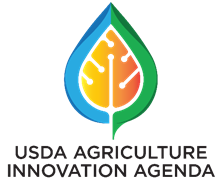Feb 20, 2020USDA introduces Agriculture Innovation Agenda
USDA Sonny Perdue today announced Feb. 20 the Agriculture Innovation Agenda, a department-wide initiative to align resources, programs, and research to position American agriculture to better meet future global demands. Specifically, the U.S. Department of Agriculture (USDA) will stimulate innovation so that American agriculture can achieve the goal of increasing production by 40 percent while cutting the environmental footprint of U.S. agriculture in half by 2050.

“We know we have a challenge facing us: to meet future food, fiber, fuel, and feed demands with finite resources. USDA’s Agriculture Innovation Agenda is our opportunity define American agriculture’s role to feed everyone and do right as a key player in the solution to this challenge,” said Secretary Perdue. “This agenda is a strategic, department-wide effort to better align USDA’s resources, programs, and research to provide farmers with the tools they need to be successful. We are also continually mindful of the need for America’s agriculture industry to be environmentally, socially, and economically sustainable to maintain our position as a leader in the global effort to meet demand. We are committed as ever to the environmental sustainability and continued success, of America’s farmers, ranchers, foresters, and producers.”
BACKGROUND:
The first component of the Ag Innovation Agenda is to develop a U.S. ag-innovation strategy that aligns and synchronizes public and private sector research. The second component is to align the work of our customer-facing agencies and integrate innovative technologies and practices into USDA programs. The third component is to conduct a review of USDA productivity and conservation data. USDA already closely tracks data on yield, but on the environmental side, there’s some catching up to do. Finally, USDA has set benchmarks to hold us accountable. These targets will help measure progress toward meeting the food, fiber, fuel, feed, and climate demands of the future. Some of the benchmarks include:
- Food loss and waste: Advance our work toward the United States’ goal to reduce food loss and waste by 50 percent in the United States by the year 2030.
- Carbon Sequestration and Greenhouse Gas: Enhance carbon sequestration through soil health and forestry, leverage the agricultural sector’s renewable energy benefits for the economy, and capitalize on innovative technologies and practices to achieve net reduction of the agricultural sector’s current carbon footprint by 2050 without regulatory overreach.
- Water Quality: Reduce nutrient loss by 30 percent nationally by 2050.
- Renewable Energy: We can increase the production of renewable energy feedstocks and set a goal to increase biofuel production efficiency and competitiveness to achieve market-driven blend rates of 15% of transportation fuels in 2030 and 30% of transportation fuels by 2050.
Read more about the Agriculture Innovation Agenda (PDF, 196 KB) here.
Secretary Perdue announced via a Prezi Presentation the Agriculture Innovation Agenda at USDA’s 2020 Agriculture Outlook Forum this morning. The theme of this year’s Outlook Forum is “The Innovation Imperative: Shaping the Future of Agriculture.” Several plenary panels and breakout sessions will focus on the central role science and innovation play in driving future growth and addressing challenges facing farmers.
Follow the conversation at #USDAinnovation on USDA’s Twitter, Instagram, and Facebook.
Produce Marketing Association response
“The Department of Agriculture has just announced the administration’s Agriculture Innovation Agenda. Max Teplitski, PMA’s chief science officer, has provided the following statement.
USDA is rolling out an initiative that will take the next bold step that will reshape agriculture. By focusing research and data efforts in agricultural sustainability, the USDA will seek to support American farmers to adopt new technologies and practices while lessening industry’s environmental footprint. Just as the healthcare industry benefited from tens of billions of dollars of federally supported research each year, it is time to afford an opportunity to do the same for agriculture.
We applaud USDA’s efforts to streamline research efforts and develop new tools that will increase sustainability of agricultural production. At PMA, sustainability means first of all, that commercial operations are economically sustainable. This gives our industry the time and means to focus on responsible stewardship of land and water that will allow farmers grow crops with minimal environmental footprint while feeding our growing world. We foster creative solutions that will allow to minimize packaging waste and promote wise energy use; we continue to support ethically responsible labor practices. We recognize a need for smart scientifically-validated tools to assess the positive impacts of horticulture on the environment.
While we welcome efforts to promote agricultural sustainability, our production practices are distinct from those of row crops and our industry is unique in another important way: produce and floral are highly perishable. Market fluctuations and even minor weather events mean million-dollar losses. Sustainability and viability of our operations critically depend on demand creation and predictable opportunities to sell produce and floral at fair market values. Conversations about sharing data have to include provisions for responsible data management so that the industry has real incentives for sharing proprietary data with our federal partners. Importantly, we need to be clear-eyed about the fact that the implementation of new practices will have a real cost. Without a doubt, conservation practices will benefit the environment and the generations of urban and rural dwellers alike. Because we will step up, we need to know that the financial burden associated with the implementation of these practices is not ours alone to carry. Everybody along the supply chain, who plays their part, needs to know that their efforts are incentivized through responsible government programs. PMA welcomes the USDA announcement and recognizes it as an investment not only in our industry and our environment but also in our consumers who deserve fresh, delicious and healthy fresh produce all year round.”














